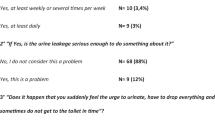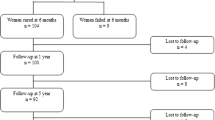Abstract
Introduction and hypothesis
The retropubic tension-free vaginal tape (TVT) procedure replaced Burch colposuspension as the primary surgical method for stress urinary incontinence (SUI) and mixed urinary incontinence (MUI) in women in our department in 1998. In this study we compared the short-term and long-term clinical outcomes of these surgical procedures.
Methods
Using a case series design, we compared the last 5 years of the Burch procedure (n = 127, 1994–1999) with the first 5 years of the retropubic TVT procedure (n = 180, 1998–2002). Information from the medical records was transferred to a case report form comprising data on perioperative and long-term complications as well as recurrence of UI, defined as bothersome UI or UI in need of repeat surgery. Other endpoints were rates of perioperative and late complications and the rates of prolapse surgery after primary surgery. The data were analyzed with the chi-squared and t tests and survival analysis using SPSS.
Results
The cumulative recurrence rate of SUI in women with preoperative SUI was significantly higher after the Burch procedure, but no difference was observed in women with MUI. There were no significant differences in rates of perioperative and late complications. At 12 years there was a significant increase in rates of repeat surgery for incontinence and prolapse in women after the Burch procedure.
Conclusions
The long-term efficacy of TVT surgery was superior to that of Burch colposuspension in women with SUI. In addition, the rate of late prolapse surgery was significantly higher after the Burch procedure.


Similar content being viewed by others
References
Tanagho EA. Colpocystourethropexy: the way we do it. J Urol. 1976;116:751–53.
Ulmsten U, Henriksson L, Johnson P, Varhos G. An ambulatory surgical procedure under local anesthesia for treatment of female urinary incontinence. Int Urogynecol J. 1996;7:81–6.
Ulmsten U, Johnson P, Rezapour M. A three year follow-up of tension-free vaginal tape for surgical treatment of female stress urinary incontinence. BJOG. 1999;106:345–50.
Wang AC, Lo TS. Tension-free vaginal tape. A minimally invasive solution to stress urinary incontinence in women. J Reprod Med. 1998;43:429–34.
Niemczyk P, Klutke JJ, Carlin BI, Klutke CG. United States experience with tension-free vaginal tape procedure for urinary stress incontinence: assessment of safety and tolerability. Tech Urol. 2001;7:261–5.
Kjølhede P. Long-term efficacy of Burch colposuspension: a 14-year follow-up study. Acta Obstet Gynecol Scand. 2005;84:767–72.
Alcalay M, Monga A, Stanton SL. Burch colposuspension: a 10-20 year follow up. BJOG. 1995;102:740–5.
Dietz HP, Wilson PD. Colposuspension success and failure: a long-term objective follow-up study. Int Urogynecol J. 2000;11:346–51.
Feyereisl J, Dreher E, Haenggi W, Zikmund J, Schneider H. Long term results after Burch colposuspension. Am J Obstet Gynecol. 1994;171:647–52.
Kulseng-Hanssen S, Berild GH. Subjective and objective incontinence 5 to 10 years after Burch colposuspension. Neurourol Urodyn. 2002;21:100–5.
Ward KL, Hilton P, UK and Ireland TVT Trial Group. Tension-free vaginal tape versus colposuspension for primary urodynamic stress incontinence: 5-year follow up. BJOG. 2008;115:226–33.
Ogah J, Cody JD, Rogerson L. Minimally invasive synthetic suburethral sling operations for stress urinary incontinence in women. S.L. Cochrane Database Syst Rev. 2015;(7):CD006375.
Nilsson CG, Palva K, Rezapour M, Falconer C. Eleven years prospective follow-up of the tension-free vaginal tape procedure for treatment of stress urinary incontinence. Int Urogynecol J. 2008;19:1043–7.
Svenningsen R, Staff AC, Schiøtz HA, Western K, Sandvik L, Kulseng-Hanssen S. Long-term follow-up of the retropubic tension-free vaginal tape procedure. Int Urogynecol J. 2013;24:1271–8.
Han JY, Park J, Choo MS. Long-term durability, functional outcomes, and factors associated with surgical failure of tension-free vaginal tape procedure. Int Urol Nephrol. 2014;46:1921–7.
Heinonen P, Ala-Nissilä S, Kiilholma P, Laurikainen E. Tension-free vaginal tape procedure without preoperative urodynamic examination: long-term outcome. Int J Urol. 2012;19:1003–9.
Olsson I, Abrahamsson A-K, Kroon U-B. Long-term efficacy of the tension-free vaginal tape procedure for the treatment of urinary incontinence. Int Urogynecol J. 2010;21:679–83.
Nilsson CG, Palva K, Aarnio R, Morcos E, Falconer F. Seventeen years’ follow-up of the tension-free vaginal tape procedure for female stress urinary incontinence. Int Urogynecol J. 2013;24:1265–9.
Glazener CMA. What is the role of mid-urethral slings in the management of stress incontinence in women? [editorial]. Cochrane Database Syst Rev. 2015;(7):10.1002/14651858.ED000101
Wall LL, Wiskind AK, Taylor PA. Simple bladder filling with a cough stress test compared with subtracted cystometry for the diagnosis of urinary incontinence. Am J Obstet Gynecol. 1994;171(6):1472–7.
Ammendrup AC, Jørgensen A, Sander P, Ottesen B, Lose G. A Danish national survey of women operated with mid-urethral slings in 2001. Acta Obstet Gynecol Scand. 2009;88:1227–33.
Meschia M, Pifarotti P, Gattei U, Bertozzi R. Tension-free vaginal tape: analysis of risk factors for failures. Int Urogynecol J. 2007;18:419–22.
Bohlin KS, Ankardal M, Pedroletti C, Lindkvist H, Milsom I. The influence of the modifiable life-style factors body mass index and smoking on the outcome of mid-urethral sling procedures for female urinary incontinence. Int Urogynecol J. 2015;26:343–51.
Pfisterer MH, Griffiths DJ, Schaefer W, Resnik NM. The effect of age on lower urinary tract function: a study in women. J Am Geriatr Soc. 2006;54:405–12.
Ebbesen MH, Hunskaar S, Rortveit G, Hannestad YS. Prevalence, incidence and remission of urinary incontinence in women: longitudinal data from the Norwegian HUNT study (EPINCONT). BMJ Urol. 2013;13:27.
Abouassaly R, Steinberg JR, Lemieux M, Marois C, Gilchrist LI, Bourque JL, Tu le M, Corcos J. Complications of tension-free vaginal tape surgery: a multi-institutional review. BJU Int. 2004;94:110–13.
Tunuguntla HS, Gousse AE. Female sexual dysfunction following vaginal surgery: a review. J Urol. 2006;175:439–46.
Serati M, Salvatore S, Uccella S, Nappi RE, Bolis P. Female urinary incontinence during intercourse: a review on an understudied problem for women’s sexuality. J Sex Med. 2009;6(1):40.
Kjølhede P, Norén B, Rydén G. Prediction of genital prolapse after Burch colposuspension. Acta Obstet Gynecol Scand. 1996;75:849–54.
Borstad E, Abdelnoor M, Staff AC, Kulseng-Hanssen S. Surgical strategies for women with pelvic organ prolapse and urinary stress incontinence. Int Urogynecol J. 2010;21:179–86.
Author information
Authors and Affiliations
Corresponding author
Ethics declarations
Funding
The study received funding from Nordland Hospital, Bodø, Norway.
Conflicts of interest
B. Holdø: none.
M. Verelst: none.
R. Svenningsen: Advisory board Astellas and speaker fees from Astellas.
I. Milsom: none.
F.E. Skjeldestad: none.
Additional information
Key message
TVT is superior to Burch colposuspension for treatment of SUI.
Rights and permissions
About this article
Cite this article
Holdø, B., Verelst, M., Svenningsen, R. et al. Long-term clinical outcomes with the retropubic tension-free vaginal tape (TVT) procedure compared to Burch colposuspension for correcting stress urinary incontinence (SUI). Int Urogynecol J 28, 1739–1746 (2017). https://doi.org/10.1007/s00192-017-3345-0
Received:
Accepted:
Published:
Issue Date:
DOI: https://doi.org/10.1007/s00192-017-3345-0




